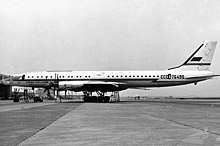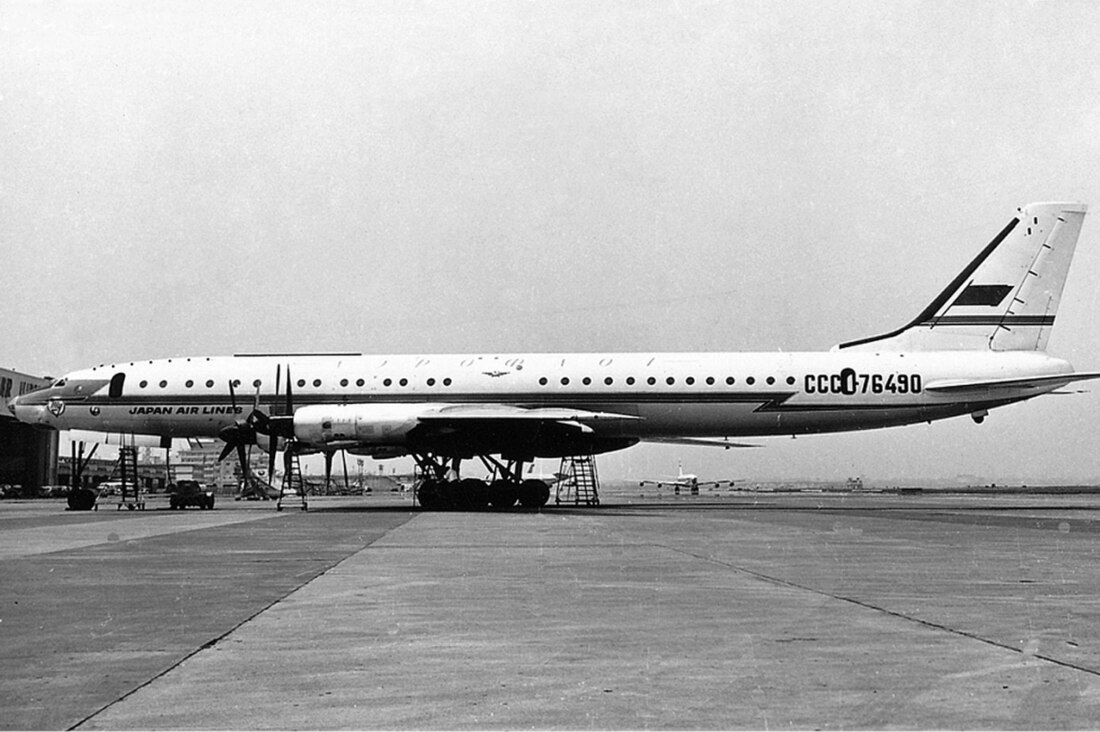Aeroflot Flight 065
1966 aviation accident From Wikipedia, the free encyclopedia
Aeroflot Flight 065 was a scheduled passenger flight operated by the International Civil Aviation Directorate division of Aeroflot. On 17 February 1966 at 1:38 am local time a Tupolev Tu-114 crashed during take-off from Sheremetyevo International Airport in Moscow, killing 21 of the 47 passengers and 19 crew members on board.[1] This was the only fatal incident involving a Tu-114.[2] A committee investigating the accident found that the crash was due to multiple crew and ATC failures.
 Sister ship of accident aircraft at Haneda Airport, Tokyo in 1965. | |
| Accident | |
|---|---|
| Date | 17 February 1966 |
| Summary | Crew and ATC errors |
| Site | Sheremetyevo International Airport 55.9699°N 37.3879°E |
| Aircraft | |
| Aircraft type | Tupolev Tu-114 |
| Operator | Aeroflot |
| Registration | CCCP-76491 |
| Flight origin | Sheremetyevo International Airport, Moscow, Russian SSR |
| 1st stopover | Conakry International Airport, Conakry, Republic of Guinea |
| Last stopover | Kotoka International Airport, Accra, Ghana |
| Destination | Maya-Maya Airport, Brazzaville, Republic of the Congo |
| Occupants | 66 |
| Passengers | 47 |
| Crew | 19 |
| Fatalities | 21 |
| Survivors | 45 |

Accident
Summarize
Perspective
On 16 February at 11:35 pm the crew of flight 065 were preparing for departure and received a weather report of visibility 700 metres (2,300 ft), with mist, light snow and a relative humidity of 100 percent. Recent snow had been cleared from the runway but not from its full 60 metres (200 ft) width. A strip approximately 40 metres (130 ft) wide had been plowed down the center of the concrete runway leaving snow 50–70 centimetres (20–28 in) deep along the runway edges.
The visibility minimum for takeoff of a Tu-114 was 1,000 metres (3,300 ft). At 1:37 am the aircraft crew radioed the control tower requesting the actual visibility and the controller reported 1,100 metres (3,600 ft). The controller later testified that he counted the runway edge lights he could see looking down the runway. He believed the distance between these lights to be 100 metres (330 ft) when in fact it was 50 metres (160 ft).
At 1:38 am the aircraft began its take-off roll one degree to the right of the runway center line. Approximately 30 seconds later the aircraft was 1,050 metres (3,440 ft) down the runway when the crew realized they were approaching the plowed snow on the right edge and overcorrected to the left four degrees. When the aircraft reached 255–260 kilometres per hour (158–162 mph), 1,400 metres (4,600 ft) down the runway the pilot rotated the nose wheels off the ground. At a distance of 1,850 metres (6,070 ft) from the beginning of the runway, accelerating through 275 kilometres per hour (171 mph), the left main landing gear entered the 60 centimetres (24 in) deep snow, causing the aircraft to yaw left and pitch down. The left main gear then impacted a runway edge light. Instead of aborting the take-off the pilot banked right, striking the propellers of engines 3 and 4 on the runway. The aircraft then spun to the right, flipped over and burst into flames. The forward fuselage and main wing section were completely destroyed. The force of the impact tore away the tail section and it came to rest inverted separated from the burning forward section. Many of the survivors were seated in this part of the aircraft.
Aircraft
The accident aircraft was a Tupolev Tu-114 with aircraft registration CCCP-76491 and manufacturer's serial number 64M472. The airliner was manufactured in 1964, delivered to Aeroflot on 12 December of that year and entered service on 18 November 1965; it was the last Tu-114 produced.
At the time of the accident, it had accumulated 93 hours with 19 take-off/landing cycles, and flown approximately 6,960 kilometres (4,320 mi).
Investigation
In a report released 12 May 1966 the investigating board indicated the main causes of the crash were errors made by the aircraft crew and poor organization of the airport traffic control service. Contributing factors included limited visibility in poor weather conditions and failure to properly clear the runway of snow.
Crews
Aeroflot Flight 65 Crews:
- Captain: Viktor Arturovich Filonov
- Reserve Captain: Alexander Nikolaevich Zhitov
- First Officer: Nikolai Alekseevich Gureev
- Reserve First Officer: Vladimir Petrovich Gromadin
- Flight Engineer: Stanislav Yulianovich Dobrochinskiy
- Reserve Flight Engineer: Nikolai Semyonovich Anishchenko
- Senior Flight Engineer: Vladimir Belyaev
- Senior Flight Engineer: Babaskin
- Navigator: Nikolai Dmitrievich Solyanov
- Reserve Navigator: Alexander Grigorievich Andreev
- Flight Operator: Vladimir Arsentievich Golenitskiy
- Reserve Flight Operator: Boris Nikolaevich Makarov
- Flight Inspector: Yury Konstantinovich Valerius
- Flight Attendant: Maria Mikhailovna Kedrina
- Flight Attendant: Tatyana Sergeevna Vinogradova
- Flight Attendant: Alla Alexandrovna Golubeva
- Reserve Flight Attendant: Olga Vladimirovna Mikhailova
- Reserve Flight Attendant: Anatoly Pavlovich Molokanov
- Reserve Flight Attendant: Lyudmila Pavlovna Markova
See also
References
Wikiwand - on
Seamless Wikipedia browsing. On steroids.
